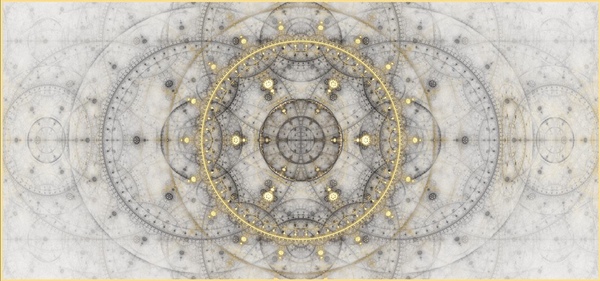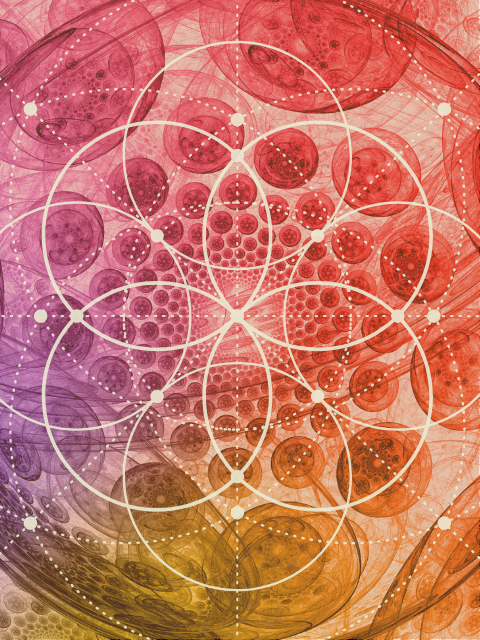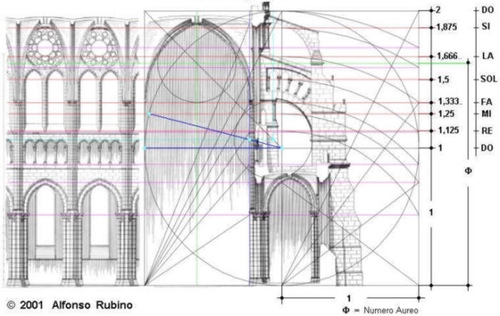In metaphysical design, the goal is to elevate us by receiving energy and harmony in our environment. One way to do this is to impose a geometric scaffolding in our designs. Upon walking into a room you should let your eyes have a pleasurable dance.
A friend and prospective client recently sought my advice about decorating her living room. She hoped a new look would bring harmony into that area. When she described what she wanted to do, her refrain was “new, new, new!” This included a new sectional sofa, new rugs, new drapes, new accessories. When she asked me what I thought, I asked her, “Why are you thinking new? Why don’t you think ancient?”
Not surprisingly, her face registered a blank look: “Huh?” I explained that a change of furnishings and accessories does not necessarily change the energy of a space. “Before thinking about what to put into a room,” I added, “one needs to address the room’s ‘bones,’ the scaffolding.”
“You mean tear down the walls? Expose the beams?”
“No,” I said. “The scaffolding I am talking about is not the physical structure but the subliminal blueprint.”
Picture entering a room for the first time. Our gaze falls first on the most striking feature. It stops there for a fraction of a nanosecond. Then shifts in another direction to take in the next feature we notice. Again our gaze pauses, and then moves to another feature. Now, imagine that the various paths our gaze has taken from one feature to the next appear as a series of fine lines. It becomes, a diagram superimposed on a photo of the room. That diagram is the room’s subliminal blueprint.
While our eyes are moving around the space, our brain is seeking some sort of order. It looks for some meaning or organizing principle that connects the various items we see. These organizing principles, operating at a subconscious level, are described by the Gestalt Laws of Perception. The Law of Similarity, is one example of the Gestalt Laws. It states that an assortment of objects will be perceived as a group if they are in some way similar to one another.
An Experiment in Seeing
To demonstrate how it works, I invited my friend to notice how her eyes moved between items of similar color. The living room’s most dominant color—cranberry red—was repeated throughout the room. It was found on a wing chair, a still life painting, a rug, an ashtray, a vase and some pillows. When I asked her to sketch the visual pathways among these various items, the pattern was jagged and erratic. In a subconscious quest for order, her eyes were zigzagging all over the place. Then I moved just a few of the red items—the throw pillows and a vase. I invited her to try again. This time she reported that her eyes traveled in a circle and she felt a sense of relaxation.
Circular movement feels good to us because it is a recurring motif in the natural world. Think of how dogs circle around each other in greeting and walk around in a circle before settling down to sleep. Think of the arcs inscribed in the air by a flock of birds, or the movement of human arms doing the breast stroke. Movements without any sharp angles impart a gliding or flowing sensation that we experience as pleasurable and calming. While both jagged lines and circles are a form of scaffolding, we instinctively prefer subliminal blueprints based on circles and arcs.
Following these patterns are where “thinking ancient” comes in. The ancient Egyptians, Greeks, and to some extent, the Romans were keenly aware of geometry and its effect on the human psyche. Native Americans and other indigenous groups around the world still carry this awareness. Most start their religious ceremonies with a prayer to the six directions. This a homage to the sacred power of geometry.

Why These Patterns Are Sacred
Why are these patterns considered sacred? The ancients believed that a geometric blueprint existed before the physical universe came into being. When matter was formed, it followed that template. They intuited the invisible scaffolding by observing the shapes and proportions that recur throughout the natural world,. This includes everything from flowers to sea creatures to internal organs. They then sought to replicate them in the man-made world.
To modern people, the notion that geometry existed before human geometers existed—even before there was matter—may be startling.
This, however, is what people the world over believed until quite recently in human history. In essence, the ancients believed that geometry was an expression of the divine mind …
….that humans discovered rather than invented.
A Brief History of Forgetfulness
The sophisticated geometry of the ancients was largely forgotten during the Dark Ages. This was a casualty of the general ignorance and barbarism of those times. The knowledge of geometry was preserved not by universities but by the medieval mason guilds. They initiated their members into the geometrical secrets of the ancient Egyptians. Their knowledge was applied to the building of churches, castles and cathedrals.
Such knowledge is how associations of literal builders came to be viewed as esoteric orders—the forerunners of modern Freemasonry. Modern people now suppose that geometry was called “sacred” because it was applied mainly to the design of churches, temples and mosques.In fact, the converse is true. Places of worship were based on geometry because it was viewed as inherently sacred: the divine blueprint for creation itself.
***
Geometry enjoyed a kind of revival during the Renaissance. Then a renewed appreciation of classical Greek and Roman architecture exerted a strong influence over contemporary design. The desire to bring accurate drawings of classical structures back to Florence led to the invention of the two point perspective. Credit for bringing the geometry of nature, also known as the mathematics of the golden mean, was given to Luca di Pacioli in his book De Divina Proportione (1496-98). Da Vinci designed the graphics.
But the Renaissance was a peculiar time It was an era at once enthralled by rediscovery of ancient learning, and hurtling toward the scientific empiricism that we think of as “modern.” As consciousness shifted from the God-centered perspective of the Middle Ages to a more human-centered view, a changed occurred. The soulfulness of right-brained geometry was supplanted by left-brained numbers and logic.
The Beginning of Arithmetic
An early harbinger of this change was the introduction of Arabic numerals in the 13th century, which enabled people to get a whole lot better at arithmetic. (Try doing a simple subtraction problem using Roman numerals—say MMCXI minus DLV—and you’ll see what I mean!) Traditional geometry was practiced with a compass and a ruler.
Often, when a geometrical expression is converted into arithmetic, the result is irrational numbers. Those are numbers that cannot be expressed as fractions. They can only be described as decimals that go on forever without repeating the same sequence. The most familiar example of this is pi. While the infinity of irrational numbers may be pleasing on a metaphysical level, it is practical. During the Victorian era, the dimensions of building materials such as bricks and beams became standardized. The use of two-by-fours made building more arithmetic-based than geometrical. Nobody uses pi when placing an order with Home Depot!
The End of Geometry
I believe the fatal blow to geometry was the empiricism of Enlightenment philosophy, which crested with David Hume in the late 18th Century. He wrote, “Beauty in things exists merely in the mind which contemplates them.” Or, as we now paraphrase Hume’s thought, “Beauty is in the eye of the beholder.” In other words, beauty is not based on anything absolute or objective. Eternal principles have nothing to do with it. The upshot of this way of thinking—which persists to this day—is that “good design” is often deemed to be whatever sort of design the powers-that-be deem correct.
Enter the Greek Revival Movement
In The Old Way of Seeing, Jonathan Hale notes when this change occurred in American architecture. During the banking revolution of the 1820s, The industry, wanted to convey an impression of power and permanence. It threw up bank buildings based on classical Greek architecture. In the beginning these reproductions were quite beautiful. Lacking a deep understanding of the geometrical principles used by the Greeks, however, eventually created problems. Many builders just imitated its superficial characteristics. The results were ill-proportioned structures, sometimes just plain ugly.
Looking for Sacred Geometry
Now, the study of sacred geometry is almost as esoteric as in the days of the medieval masons. If we care to investigate, we can find much of the available material rather daunting in its complexity. Had we been trained as children in the mathematics of nature, art and beauty, all would be easier to understand. Instead we were instructed in the mathematics of technology and war.
We can also find books that treat its study as a spiritual practice. Those authors believe that meditating on sacred geometry enhances oneness with the cosmos. I am not great at meditation, but I do believe this geometry calms me down. Simply rearranging a few accessories in accordance with geometric laws brought serenity to my friend. She liked the energy of her living room better, without spending a dime on anything new. If meditating on a circle in the form of a mandala brings a sense of inner peace, why not live in one?
***
Regardless of where we stand philosophically—whether we believe in the big bang theory or a static universe, —we do not have to accept that geometry existed before matter to enjoy its benefits. We don’t even have to call it “sacred.” The essence of using geometry is observing the shapes and proportions that we find in the natural world and incorporating them into our designs. The eternal principles of the ancients translate rather readily into decorating tips and tricks, many of which I’ll be sharing in upcoming articles.
***
Every room has a subliminal scaffolding. When that scaffolding is inspired by the creative forces of the universe, the eyes engage in a pleasurable dance. Mind and body align with its movement, a sort of tai chi for the eyes. [1]
***
[1] Tai chi is a series of movements designed to bring chi into the body. The same energy, I believe, can enter the body through the eyes when they perceive the scaffolding of nature found in sacred geometry.
***
There are two parts to this website, The Lessons, which are more difficult in concept, and the blogs, which are lighter in nature.
A lesson that relates to this blog is:
III. Finding Energy Through Geometric Patterns
A blog with a similar theme is:
The Mathematics of Nature in the Most Unusual Places
Please note that my website allows you to leave comments at the end of the blogs but not at the end of each lesson. If you have a comment or question about a lesson, you may email me at ruta@rutas-rules.com



